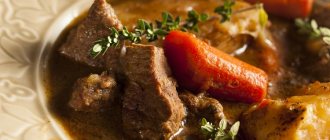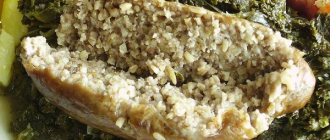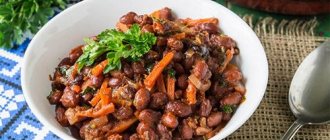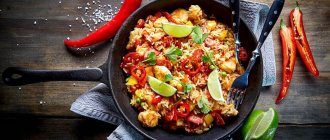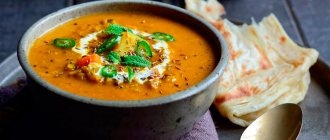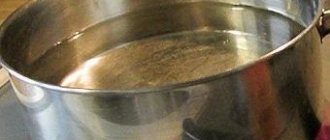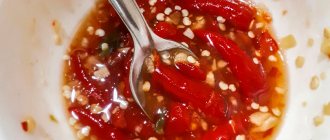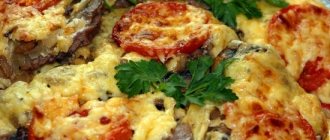Edited by an expert:
Nadezhda Primochkina, nutritionist - 06.27.2020
The history of Georgian cuisine goes back several thousand years, and its modern popularity far beyond the country’s borders is explained by the careful attitude of Georgian chefs to national culinary traditions.
Dishes of Georgian cuisine are distinguished by their brightness of appearance and taste, a pronounced national coloring, which is ensured by the use of a characteristic set of vegetables, a large amount of herbs and unique Georgian cheeses.
In addition to the dishes themselves, Georgian cuisine is also a tradition of feasting, where communication is as important as the meal itself. The very concept of a snack or fast food is absurd for Georgia.
Famous Georgian khachapuri
In January 2020, the popular dish of Georgian cuisine - khachapuri - was awarded the status of intangible heritage of Georgia.
The name of this dish of national Georgian cuisine is translated as cottage cheese with bread: “khacho” - cottage cheese and “puri” - bread. It is deservedly considered a significant component and hallmark of national cuisine. .
The dish does not have a single recipe; famous khachapuri is prepared in different regions in its own way.
The most common types:
- Adjaruli is one of the most famous species. Adjarian khachapuri in the shape of a boat stuffed with cheese. The egg is broken just before it is ready and kept in the oven until the white is baked, while the yolk remains half-baked.
- Imeruli - Imeretian khachapuri. It is a closed flatbread made from yeast dough filled with fatty varieties of young cheese. Imeruli are baked in clay pans or in an oven.
- Megruli is a Megrelian version of khachapuri. Almost completely identical to imeruli, the difference is: the top of the flatbread is thickly sprinkled with cheese.
- Rachuli is a traditional square shape, filled with cheese, the top is greased with yolk.
- Guruli is a crescent-shaped khachapuri stuffed with cheese and egg. A traditional dish for the Christmas feast.
- Svanuri - Svan khachapuri, unlike others, can be made not only with cheese, but also with meat.
- Achma is the queen of khachapuri. A multi-layer baked pie made from layers of boiled dough, brushed with butter and topped with cheese.
To prepare real khachapuri of Georgian cuisine at home, you can use recipes with step-by-step photos that are regularly provided by culinary magazines.
Interesting! You can use any kind of cheese for the filling, but in Georgia they never put suluguni in khachapuri.
Georgian cheeses
One of the features of Georgian national cuisine recipes is the widespread use of cheeses. There are more than 250 species of them, and they are known only in their own territory. Georgians make cheeses from lamb, goat, sheep, cow and buffalo milk.
Cheeses are divided into several types depending on the preparation technology and are:
- freshly brewed;
- smoked;
- dried,
- young (aged for several days).
Almost all Georgian cheeses are brined, often not fully ripened. They are used in Georgian recipes when preparing soups and main courses and are even fried on skewers.
The most famous of the officially registered varieties are:
- suluguni – layered brine cheese;
- Imeretian - fresh cheese with a mild taste; Georgian housewives most often use it to make khachapuri in their home kitchens;
- Adjarian chechili is a cheese made from cow's milk that looks like a twisted rope.
In addition to the heads, Suluguni is made into sheets, formed into a horn or a bag, which is stuffed with cottage cheese or other soft cheese (for example, naduti).
Interesting! Unique, signature cheeses are also made in Georgia. During ripening, such cheese is kept in honey or wine, and aromatic herbs, nuts, spices, and cocoa are added.
Nuts and aromatic herbs
All dishes of Georgian cuisine are tasty and aromatic. They are made this way by herbs, cultivated and wild, and various nuts, which are widely used in Georgian cooking.
The most commonly used nuts are:
- walnuts;
- hazel (wild hazelnut);
- hazelnut;
- almond.
Nuts are not only an indispensable ingredient in sauces and seasonings, but also a full-fledged component of cold salads, soups, hot main courses and confectionery.
Thanks to the warm and mild climate, fresh herbs are available throughout the year. They are used in cooking and eaten fresh, wrapped in pita bread. No meal is complete without some greenery on the table. Various spices are prepared from dried aromatic herbs: hops-suneli, utskho-suneli, Svan salt and dry adjika.
Herbs typical of Georgian national cuisine: basil, parsley, savory, caraway, cilantro, marjoram, fenugreek, Imeretian saffron and mint.
Georgian sauces
The peculiarity of Georgian sauces is that they are always based on vegetable raw materials. This could be fruit or tomato juices and purees, crushed nuts or garlic. In addition, each sauce uses a specific set of spices.
Sauces are served with meat, fish, vegetables or eaten as a separate dish with bread.
The most common sauces:
- tkemali – sauce made from small tkemali plums with garlic and herbs;
- satsivi - nut sauce in chicken broth with garlic;
- satsibelli – spicy tomato sauce with garlic;
- garo – nut sauce with garlic and cilantro, diluted with broth and wine vinegar.
Most sauces have a fairly liquid consistency. It is their use together with basic products that allows us to create such culinary abundance.
Chicken satsivi
Satsivi is a traditional Georgian sauce made from walnuts and spices. An artful array of spices adds a zesty flavor, cilantro adds freshness, and lemon juice adds sourness. A whole group of national dishes are prepared with this sauce in Georgia: satsivi made from chicken, turkey, duck, beef or fish. The first option is considered a classic. If in the “hot dishes” section of the menu it is simply written “satsivi”, then the dish will be prepared with chicken in nut sauce. In other cases there will be clarifications. Be sure to try the sauce separately and as part of a meal of the same name. This spicy buttery taste will be remembered for a long time.
Soups of national cuisine
A national feature of the first courses of Georgian cuisine is the absence of vegetable grounds, and the thickness of the soup is achieved by adding a mixture of eggs with fruit juice or matsoni.
Examples of the most famous first courses:
Kharcho – beef rice soup with tkemali, walnuts and garlic. During the cooking process, a lot of greens are added to the soup.
Hashi is a soup made from beef legs and stomach. Cook until the meat comes off the bones and the tripe is tender. A lot of cilantro and parsley are placed on a plate of hashi.
Interesting! Traditionally, khashi is prepared and served completely without salt. The salt shaker, garlic and milk are placed on the table next to the soup.
Chikhitrma is a thick meat (lamb, chicken or turkey) soup with narsharab or tkemali puree, thickened with fried onions, corn flour and beaten eggs. In addition to traditional cilantro, parsley and basil, mint and saffron are also added to chikhitrma.
In addition to those listed, the menu of Georgian cuisine includes fish, vegetable and fermented milk soups. Some take about 20 hours to prepare (hashi), others are simple and no less tasty, and are prepared quickly. Such Georgian recipes are often prepared by housewives in the home kitchen, not only in Georgia.
Interesting! A very unusual chrianteli soup - onions, spices and herbs are boiled in cherry juice. The cherry “broth” is poured into plates and finely chopped cucumbers, finely crushed walnuts and chopped garlic are added.
Classic recipe
Georgians (the recipe with the photo in a frying pan is better known among housewives) with tomato sauce does not require any special knowledge. The option is described in full with the preparation of the base, which can easily be replaced with store-bought dumpling dough.
Composition of ingredients
Food set for filling and gravy:
- mixed minced meat – 300 g;
- onions – 2 heads;
- tomato paste – 50 g;
- garlic – 1 clove;
- carrots – 1 pc.;
- vegetable oil – 4 tbsp. l.;
- salt, black pepper - to taste.
For the test:
- premium flour - 2 tbsp;
- egg – 1 pc.;
- water – 1 tbsp.;
- salt.
What can be added and changed in the composition
You can add bell and hot peppers to the sauce, and use tomato juice instead of tomato paste, but you may then have to add a little sugar so that the sauce does not turn out too sour.
Georgians. Classic recipe with photo.
For the filling, some people buy or prepare ground beef or chicken to reduce calorie content.
Step-by-step cooking process
Step by step guide:
- You need to start by preparing the base, for which you first need to sift the flour into a large cup or on the table. Next, you need to mix it with a small amount of salt and create a slide.
- Separately, you need to combine water with the egg and pour the resulting mixture into the recess made on the top of the flour.
- Knead the dough into a fairly stiff dough, wrap it in film and set aside for 30 minutes. to the side.
- You need to defrost the minced meat first, add 1 very finely chopped onion, pressed garlic, salt, pepper and use your hands to achieve a homogeneous mass.
- The remaining onion should be cut into cubes and the carrots should be grated. Vegetables must be sautéed in a small amount of oil in a frying pan. Place half of the mixture on a plate, and add the remaining frying tomato paste, add a little water and simmer over low heat for 5 minutes.
- By this time the dough has already rested; it should be rolled out thinly into a rectangle shape. First, spread the minced meat on the surface, place the sautéed vegetables from the plate on top and roll the roll, being careful not to leave any air inside.
- Now you need to cut the product into columns no more than 4 cm high, roll them on all sides in flour and fry the ends of the Georgians in a saucepan until golden brown.
- The resulting semi-finished products must be poured with tomato sauce. Cook covered over low heat for another 30 minutes.
Decoration and serving rules
You can serve it in portions on plates or on a large platter, sprinkling the dish with chopped herbs. It’s better to add a sauce of sour cream or mayonnaise mixed with garlic next to it.
Meat dishes
Georgian meat cuisine, having neither religious nor climatic restrictions, contains recipes from all types of meat: pork, beef, chicken and turkey. But beef remains Georgians’ favorite meat.
Khinkali are thin dough bags with a juicy meat filling. It is believed that in all Georgian cuisine the best khinkali are made in Pshavi, Khevsureti and Tisheti. The dish is known far beyond Georgia.
There are certain traditions on how to eat khinkali correctly:
- Khinkali is eaten only with hands.
- Initially, each khinkali should be sprinkled with pepper, bitten and drunk, and only then eaten.
Interesting! Georgians do not eat the top of the khinkali - the place where the dough is pinched. It is called "kudi". It is by the number of kudi that the number of khinkali eaten is determined.
Mtsvadi - the famous Georgian kebab - is an integral part of all celebrations and feasts. There are a lot of recipes and marinades for mtsvadi.
But real Kakheti kebab is made from fresh meat, not marinated at all and fried over grapevine coals. Remove the finished mtsvadi from a skewer with a piece of lavash into a deep bowl, sprinkle with onion rings and pour over squeezed pomegranate juice.
Chakhokhbili is a national meat (most often chicken) stew with vegetables (onions, tomatoes, sometimes potatoes) and spices. The peculiarity of the dish is that the meat is first fried, then stewed with selected vegetables.
Satsivi is a dish of national Georgian cuisine made from chicken. Boiled, then baked in the oven, chicken, cut into pieces with satsivi sauce.
Georgians Recipe With Photo Step by Step in the Oven
➡➡➡ CLICK HERE FOR MORE DETAILS!
Georgians, although they look like lazy dumplings - they are also rolls made from dumpling dough with minced meat, but they are prepared differently, and accordingly Georgians have a slightly different taste. What’s convenient is that this dish can be prepared in large quantities at once, and then reheated, and in... 200 ml of milk, 1 egg, 400g of flour, 1 tbsp. l. vegetable oil, a pinch of salt, 500g minced meat, 200g onions, 1 clove of garlic, salt, pepper to taste, 50g of tomato paste, 2 medium carrots, 2 cloves of garlic, 1 onion (at least 150g), salt, pepper... Georgians - These are rolls with minced dumpling dough, stewed with carrots and onions. The cooking principle is very similar to Ready-made Georgians, served as an independent dish with fresh herbs and sour cream. To avoid losing the recipe, subscribe to the channel! Water - 200 milliliters, flour - 500 grams, meat - 350 grams, onion - 2 pieces, carrots - 1 piece, tomato sauce - 100 milliliters, vegetable oil - 2 tbsp. spoons, salt and pepper - to taste. This recipe has been around for many years. A Jewish woman taught me this in my youth. During this period, the recipe has undergone some changes. This is the number one dish both on weekdays and on holidays. Before arriving, my friends and relatives always ask: “Will there be Georgians?” Minced meat - 400 g, onion - 2 pcs., carrots - 2 pcs., flour - 300 g, eggs - 1 pc., salt - 0.2 g, tomato paste - 1 table. l., water - 600 ml, onion - 1 pc., bell pepper - 1 pc. Step 1: Prepare the indicated products. My minced meat is homemade, chicken and pork. Pictures on request “Georgians Recipe With Photo Step by Step in the Oven” How to cook Georgians, step by step recipe with photos. You can use any minced meat you like. Step-by-step photo recipe: Georgians. We prepare the products. Mix the dough. How to marinate and deliciously cook chicken wings in the oven, slow cooker, in a frying pan... Chicken eggs 2-3 pieces, purified water 4 tablespoons, salt to taste, premium wheat flour 400 grams, minced pork and beef or fresh chicken 500 grams, medium-sized garlic 2 cloves, ground black pepper to taste... recipe. Georgians. Roll out the dough into a layer approximately 3 mm thick, spread the minced meat (3 mm) evenly over it and carefully wrap it into a roll, the diameter of which should not exceed 5 cm. Cut the roll into bars 3-4 cm long and fry them on both sides (meaning ... "Georgians" is an original dish that will appeal to all lovers of dumplings. This wonderful delicacy has many Considers cooking to be a real art. The editor of "With Taste" loves simple recipes with an unusual presentation, even the classic... Georgians or lazy dumplings. A hearty hot dish with tender dough, minced meat and vegetables in the oven. Place fried onions and carrots on the Georgians, add water and simmer over medium heat for 20-30 minutes. Bon appetit. Bon appetit! Name. Recipe for Georgians with minced meat in a frying pan - Photo step by step. School-culinary www.FoodBest.ru/recipe/gruzinchiki-poshagovy-j-retsept-s-foto/ Georgians step-by-step recipe with photos. The recipe for Georgians appeared in our family a long time ago. It is made quite simply, and pour the prepared sauce on top. Place in the oven for 30 minutes. The Georgian recipe is ready. The dish can be served to the table. Flour - 500 grams, water - 200 ml, egg - 1 piece (optional), salt - 0.5 tsp, minced meat - 500 grams, onion - head, garlic - 3 cloves (optional), spices: salt , ground black pepper, dried or fresh herbs, sour cream - 2 tbsp. l, ketchup (tomato paste)…Georgians))). You will need minced meat, dumpling dough, carrots, onions, greens. The recipe is called Rosary. Thinly sliced onions are placed in the rolls (I’m really not about Inserting an image. The photo is inserted into the text. You can insert a few more or close this window. Georgians are delicious rolls with meat, which will especially appeal to lovers of dumplings and khinkali. The aromatic dish is baked in A step-by-step recipe for preparing Georgians with cheese: first, make the filling for a hearty dish. Mix the minced meat with salt, pepper and... Next, put the products in the oven, bake for 20 minutes. That's it - the Georgians are ready! The cooking recipe, as you can see, is quite simple. Place on a baking sheet. Bake in the oven for forty minutes. After the specified time, delicious... Minced meat and dough as for dumplings. 2 cups flour. 4 eggs. 1 tbsp. . butter. 1 cup water. 100 g. beef. 100 g. pork. 2 onions. 0.25 cup water. salt. pepper. tomato paste-2-3 tablespoons. lots of carrots and onions. oil 3 tablespoons. Roll out the dough into a layer 3mm thick. evenly... Minced meat - 400 gr., flour - 300 gr., chicken egg - 1 pc., salt - 2 gr., water - 600 ml., onions - 3 pcs., carrots - 3 pcs., greens - 10 gr., vegetable oil - 20 ml. Step 1 of 11 First, let's prepare the base, the dough. Flour - 1 cup (heaped), water (boiling water) - 1/2 cup, salt - to taste, vegetable oil - 2 tbsp. l., minced meat, onions, salt, black pepper, red pepper, herbs, a little liquid (water), tomatoes (juice, paste or ketchup), sour cream, bay leaf... 250 ml mineral water, 1 tsp. salt, 2 tsp sugar, 2 eggs (1 in dough and 1 in minced meat), 1 carrot, 4 cups. flour, 1 kg minced meat (I used pork), onion, salt, pepper, parsley, cumin. We prepare the products. Mix the dough. While it settles, make the minced meat. Pour the fried Georgians with tomato sauce. Place vegetables on top. Simmer the Georgians for about 20 minutes until fully cooked. Tweet Stuffed pita bread baked in the oven is a very tasty snack that has many cooking options. I finally decided to post the Georgian recipe. Maybe this dish is called something else, of course, but I’m different. I’m also a new person here. And I am pleased to see such first posts. The recipe is good! The letters are good! I would like to see better quality photos. Place the finished “Georgians” on a plate and serve hot with sour cream or mayonnaise. Bon appetit. Very tasty, can be cooked with other minced meat, or without pumpkin. vkusnaya-zona.ru/gruzinchiki “Gruzinchiki” is an original dish that will appeal to all lovers of dumplings. This wonderful delicacy has many names. We have prepared a quick and simple recipe for this dish for you. Please your loved ones today! Georgians. 40 minutes. 4 servings. Place the finished “Georgians” on a plate and serve hot with sour cream or mayonnaise - to your taste. And enjoy! and I liked the recipe and step-by-step preparation, and the smiley made me especially happy with the debut. I just pour hot sauce over the fried Georgians and let it brew. Valjuschka Wonderful recipe! And the photos are so delicious. I'm afraid that it won't come to seasoning with sauce: they will already be fried and melted away. Georgians, although they look like lazy dumplings - they are also rolls made from dumpling dough with minced meat, but they are prepared differently, and accordingly Georgians have a slightly different taste. What’s convenient is that this dish can be prepared in large quantities at once, and then reheated, and in... 200 ml of milk, 1 egg, 400g of flour, 1 tbsp. l. vegetable oil, a pinch of salt, 500g minced meat, 200g onions, 1 clove of garlic, salt, pepper to taste, 50g of tomato paste, 2 medium carrots, 2 cloves of garlic, 1 onion (at least 150g), salt, pepper... Georgians - These are rolls with minced dumpling dough, stewed with carrots and onions. The cooking principle is very similar to Ready-made Georgians, served as an independent dish with fresh herbs and sour cream. To avoid losing the recipe, subscribe to the channel! Water - 200 milliliters, flour - 500 grams, meat - 350 grams, onion - 2 pieces, carrots - 1 piece, tomato sauce - 100 milliliters, vegetable oil - 2 tbsp. spoons, salt and pepper - to taste. This recipe has been around for many years. A Jewish woman taught me this in my youth. During this period, the recipe has undergone some changes. This is the number one dish both on weekdays and on holidays. Before arriving, my friends and relatives always ask: “Will there be Georgians?” Minced meat - 400 g, onion - 2 pcs., carrots - 2 pcs., flour - 300 g, eggs - 1 pc., salt - 0.2 g, tomato paste - 1 table. l., water - 600 ml, onion - 1 pc., bell pepper - 1 pc. Step 1: Prepare the indicated products. My minced meat is homemade, chicken and pork. Pictures on request “Georgians Recipe With Photo Step by Step in the Oven” How to cook Georgians, step by step recipe with photos. You can use any minced meat you like. Step-by-step photo recipe: Georgians. We prepare the products. Mix the dough. How to marinate and deliciously cook chicken wings in the oven, slow cooker, in a frying pan... Chicken eggs 2-3 pieces, purified water 4 tablespoons, salt to taste, premium wheat flour 400 grams, minced pork and beef or fresh chicken 500 grams, medium-sized garlic 2 cloves, ground black pepper to taste... recipe. Georgians. Roll out the dough into a layer approximately 3 mm thick, spread the minced meat (3 mm) evenly over it and carefully wrap it into a roll, the diameter of which should not exceed 5 cm. Cut the roll into bars 3-4 cm long and fry them on both sides (meaning ... "Georgians" is an original dish that will appeal to all lovers of dumplings. This wonderful delicacy has many Considers cooking to be a real art. The editor of "With Taste" loves simple recipes with an unusual presentation, even the classic... Georgians or lazy dumplings. A hearty hot dish with tender dough, minced meat and vegetables in the oven. Place fried onions and carrots on the Georgians, add water and simmer over medium heat for 20-30 minutes. Bon appetit. Bon appetit! Name. Recipe for Georgians with minced meat in a frying pan - Photo step by step. School-culinary www.FoodBest.ru/recipe/gruzinchiki-poshagovy-j-retsept-s-foto/ Georgians step-by-step recipe with photos. The recipe for Georgians appeared in our family a long time ago. It is made quite simply, and pour the prepared sauce on top. Place in the oven for 30 minutes. The Georgian recipe is ready. The dish can be served to the table. Flour - 500 grams, water - 200 ml, egg - 1 piece (optional), salt - 0.5 tsp, minced meat - 500 grams, onion - head, garlic - 3 cloves (optional), spices: salt , ground black pepper, dried or fresh herbs, sour cream - 2 tbsp. l, ketchup (tomato paste)…Georgians))). You will need minced meat, dumpling dough, carrots, onions, greens. The recipe is called Rosary. Thinly sliced onions are placed in the rolls (I’m really not about Inserting an image. The photo is inserted into the text. You can insert a few more or close this window. Georgians are delicious rolls with meat, which will especially appeal to lovers of dumplings and khinkali. The aromatic dish is baked in A step-by-step recipe for preparing Georgians with cheese: first, make the filling for a hearty dish. Mix the minced meat with salt, pepper and... Next, put the products in the oven, bake for 20 minutes. That's it - the Georgians are ready! The cooking recipe, as you can see, is quite simple. Place on a baking sheet. Bake in the oven for forty minutes. After the specified time, delicious... Minced meat and dough as for dumplings. 2 cups flour. 4 eggs. 1 tbsp. oil 1 cup water 100 g beef 100 g pork 2 onions 0.25 cup water salt pepper tomato paste 2-3 tablespoons lots of carrots and onions oil 3 tablespoons Roll out the dough into a layer 3mm thick. evenly... Minced meat - 400 gr., flour - 300 gr., chicken egg - 1 pc., salt - 2 gr., water - 600 ml., onions - 3 pcs., carrots - 3 pcs., greens - 10 gr., vegetable oil - 20 ml. Step 1 of 11 First, let's prepare the base, the dough. Flour - 1 cup (heaped), water (boiling water) - 1/2 cup, salt - to taste, vegetable oil - 2 tbsp. l., minced meat, onions, salt, black pepper, red pepper, herbs, a little liquid (water), tomatoes (juice, paste or ketchup), sour cream, bay leaf... 250 ml mineral water, 1 tsp. salt, 2 tsp sugar, 2 eggs (1 in dough and 1 in minced meat), 1 carrot, 4 cups. flour, 1 kg minced meat (I used pork), onion, salt, pepper, parsley, cumin. We prepare the products. Mix the dough. While it settles, make the minced meat. Pour the fried Georgians with tomato sauce. Place vegetables on top. Simmer the Georgians for about 20 minutes until fully cooked. Tweet Stuffed pita bread baked in the oven is a very tasty snack that has many cooking options. I finally decided to post the Georgian recipe. Maybe this dish is called something else, of course, but I’m different. I’m also a new person here. And I am pleased to see such first posts. The recipe is good! The letters are good! I would like to see better quality photos. Place the finished “Georgians” on a plate and serve hot with sour cream or mayonnaise. Bon appetit. Very tasty, can be cooked with other minced meat, or without pumpkin. vkusnaya-zona.ru/gruzinchiki “Gruzinchiki” is an original dish that will appeal to all lovers of dumplings. This wonderful delicacy has many names. We have prepared a quick and simple recipe for this dish for you. Please your loved ones today! Georgians. 40 minutes. 4 servings. Place the finished “Georgians” on a plate and serve hot with sour cream or mayonnaise - to your taste. And enjoy! and I liked the recipe and step-by-step preparation, and the smiley made me especially happy with the debut. I just pour hot sauce over the fried Georgians and let it brew. Valjuschka Wonderful recipe! And the photos are so delicious. I'm afraid that it won't come to seasoning with sauce: they will already be fried and melted away.
Antidepressants List of the Best Without Prescriptions
Bean Dishes Recipes Quickly
Puff Pastry Roll Recipe
Olivier With Chicken Breast Recipe
Coho Salmon in the Oven Recipe With Photo
Vegetable and fish dishes
The main vegetables of national Georgian cuisine are grain beans, eggplants, cauliflower and white cabbage, tomatoes and beets. Along with garden vegetables, young beet tops and wild herbs are used: purslane, jonjoli, china, nettle and others.
A significant place in Georgian cuisine is occupied by dishes made from grain beans - lobio. Various seasonings and vegetables, sometimes Imeretian cheese, are added to the finished beans. More than 20 lobio recipes are prepared in Georgia.
Examples of vegetable dishes:
- lobio – boiled beans with herbs, onions and nuts;
- chogi – boiled beets in dogwood puree with onions and spicy herbs;
- Pepper mkhali – finely chopped baked sweet peppers with nuts, garlic, wine vinegar and herbs.
Another popular vegetable is eggplant. It is boiled, baked on a grill, stewed, fried, stuffed and salted - several dozen dishes.
Interesting! In Georgian cuisine, raw vegetables are used only for salads, and in most recipes for vegetable dishes they are stewed, boiled, fried or pickled.
Fish dishes are not particularly common in Georgia. They are prepared in areas located near rivers. They are home to different species of carp and trout.
The fish is mainly boiled or stewed and served with various sauces.
Georgian recipes and dishes
The Suram Pass divides Georgia into two geographical parts. Everything that is located west of Suram is Western Georgia, smaller in territory, but with greater natural, ethnographic and historical diversity. To the east of the Suram Pass, Central and Eastern Georgia are located in a different natural zone.Speaking about Georgian cuisine, one cannot help but mention the main differences between the cuisines of Western and Eastern Georgia, due not only to the different natural conditions of these two large regions, but also to the well-known Turkish influence on the cuisine of Western Georgia and Iranian influence on the cuisine of Eastern Georgia. As a result, a difference was established in the use of some basic products (bread, meat) and partly in the nature of the favorite aromatic and flavor range - a difference that has remained until our time.
Thus, in Western Georgia, bread and special flatbreads made from corn flour - mchadi - are widespread, while in Eastern Georgia they prefer wheat bread. In some parts of Western Georgia - Megrelia and Abkhazia - they also use chumiza (a type of millet) as bread, from which they cook a mushy mass - gomi, which is used instead of bread with soups, meat and vegetable dishes. As for meat, in Eastern Georgia, along with the main meat for Georgians - beef, they also eat lamb, and consume quite a lot of animal fats, while in Western Georgia they eat much less meat, preferring poultry, i.e. mainly chickens and turkeys (geese and ducks are not eaten in Georgia). Finally, in Western Georgia they use spicier dishes and slightly different sauces.
All this, however, does not give grounds to draw an insurmountable line between Western and Eastern Georgian cuisines, since it does not affect or change the basic, characteristic features of Georgian national cuisine. And in the area of using the vast majority of products, and even more so in the area of technology, Georgian cuisine as a whole has its own characteristics. Let's take, for example, meat dishes, so common in Transcaucasia. The long existence of the Georgian nation at the intersection of many cultures and influences has led to the fact that in general, in Georgian cuisine, no one type of meat has a predominant importance.
Georgian meat dishes can be made from pork (muzhuzhi), lamb (chanakhi), beef (kharcho) and poultry (chakhokhbili). Such tolerance is usually not characteristic of other peoples of the East. It is quite clearly illustrated, by the way, by one ancient dish of Georgian cuisine called “bull on a spit.” Its composition is extremely simple: a calf is placed inside a whole bull carcass, a lamb is placed inside the calf, a turkey is placed in the lamb, a goose is placed in the turkey, a duck is placed in the goose, and a chicken is placed in the duck. In the spaces between these animals and inside them, spicy herbs are stuffed into all corners - cilantro, basil, tarragon, leeks, mint, flavored and sprinkled with red pepper, garlic, saffron, cinnamon and nuts. This whole giant roast is roasted on a spit, right outside, over a pile of coal for several hours. On the outside, a fairly thick layer of it becomes charred, so that some of the meat disappears. But inside there is such an abundance of juice, such a unique aroma that no meat dish in the world can compare with it in terms of the juiciness and subtlety of the taste of the meat. However, tolerance for all types of meat does not prevent Georgians from loving beef and poultry most of all - turkey and chicken.
Compared to meat, fish dishes occupy a relatively modest place in Georgia, and even then only in certain areas located near rivers. It should be emphasized that typical fish species for Transcaucasia are barbel, khramulya, shemaya, podust, which belong to the carp family and are distinguished by exceptionally tender and fatty meat. In the high-mountainous clear and fast rivers of Abkhazia, Svaneti, Khevsureti and Upper Kartalinia, trout is common, the meat of which is also exquisitely tasty and does not have a specific “fishy” taste. These features of local fish raw materials, combined with the relatively rare and insignificant use of fish compared to meat in Georgian cuisine, left their mark on the nature of Georgian fish preparation. It is consumed mainly boiled and stewed and flavored with the same sauces and seasonings as meat or vegetable dishes.
The formation of a Lenten table in Georgian cuisine, unlike, for example, Russian cuisine, went along the line of developing not fish and mushroom dishes, but mainly vegetable and fruit ones. This was prompted by the natural environment itself. As a result, vegetable dishes began to occupy a large and almost dominant place in Georgian cuisine, if we take into account the variety of their types. Most of them are prepared from beans, eggplants, cabbage and cauliflower, beets, and tomatoes. These are the so-called staple vegetables. Along with garden vegetables, wild herbs are widely used - nettle, china, mallow, john-jolie, purslane and others, as well as young tops of garden crops - beets, cauliflower. Vegetable dishes should also include various types of products from grain crops: spelt - zanduri, chumiz, rice, corn.
Vegetable dishes in Georgian cuisine can be raw, such as salads, but most often they are boiled, baked, fried, stewed, pickled or salted. The most common combination is a combination of one main vegetable (for example, beans, eggplant) with a variety of changing seasonings. These are, for example, dozens of types of lobio. In other cases, on the contrary, the main vegetables (cabbage, beans, eggplant, beets, spinach) in the dish change, but seasonings, sauces, and gravies remain unchanged. These are vegetable dishes such as mkhali and borani. Nuts occupy a large place in Georgian cuisine - hazel, hazelnuts, beech nuts, almonds, but most often walnuts. This specific raw material is an invariable component of various seasonings and sauces, equally well suited to poultry, vegetable and even fish dishes. Nuts are used in meat soups and confectionery, in cold salads and hot main courses. Without them, in short, the Georgian table is unthinkable.
Finally, spicy herbs, consumed throughout the year, have acquired great importance in Georgian cuisine. These are cilantro, tarragon, basil, savory, leek, green onions, and partly mint. Another distinctive feature of the Georgian table is the frequent and plentiful consumption of cheeses. First of all, the composition of the cheeses attracts attention. These are exclusively brine-type cheeses, prepared mainly using the jug and partly the wineskin method. In Western Georgia, the production of mild, fresh cheeses with a sour-milk taste is concentrated - Suluguni and Imeretian, which are widely used in cooking. In the high-mountainous northern regions of Eastern Georgia, sharp and salty cheeses are made - Kobi, Tushinsky, Georgian, Guda, Chanakh, Ossetian. Not only the taste range, but also the methods of using Georgian cheeses are very different from European ones. If in European cuisines various cheeses belong mainly to either the appetizer or dessert table, then in Georgian cuisine they are used in the preparation of hot dishes, both second and first (gadazelili). In Georgian cuisine, cheese is boiled or boiled in milk, fried on a spit or in a frying pan in oil, baked in dough, soaked, pounded, flavored with oil and spices. These features of cheese consumption are largely due to the fact that Transcaucasian cheeses very often do not undergo the full ripening process and are typical semi-finished products, as well as with the common desire among a number of ancient mountain peoples to transfer the methods of cooking meat to other livestock products, to adapt them, for example, for cheese. Thus, boiling and frying cheese is characteristic of Swiss cuisine, and Georgian cuisine is also characterized by the method of frying cheese on a spit.
The widespread use to this day of open fire and spit for cooking not only meat, but also vegetable, fish and even cheese dishes, as well as the use of a clay jug-shaped Torne oven for baking flour products in general is typical, of course, not only for Georgian, but also for other Transcaucasian cuisines. More specific are the ketsi used by Georgians for frying and baking - small clay and large stone frying pans, as well as wide metal tapa frying pans for frying poultry under pressure. And although the last technique was borrowed in ancient times from the Armenians, it became much more widespread in Georgian cuisine. All these technological methods, however, serve as only one of the elements of creating a national culinary flavor in Georgian cuisine. Another, outwardly less attention-grabbing, but more significant and truly national feature of Georgian cooking is the use of special techniques to create a variety of dishes. Of these techniques, two should be mentioned: the use of sour, sour-fat and sour-egg medium to create a unique taste and consistency of Georgian soups and the use of sauces to enrich the range of main courses.
Georgian soups are almost devoid of vegetable grounds. But their consistency is much denser than other soups. Very often this is achieved by introducing egg yolks or whole eggs into them. To prevent eggs from curdling when heated, the following method is used: they are pre-mixed into a single emulsion with some acidic medium - natural sour fruit juice, sour milk (matsoni) or vinegar. Especially often thickened and dried tkemali plum puree, called tklapi, is used as an acidic medium. An acidic environment is also used in soups when there are no eggs, but there is quite a lot of fat and meat. This not only improves and diversifies the taste of dishes, but also significantly increases their digestibility. Like French cuisine, Georgian cuisine is unthinkable without sauces. At the same time, Georgian sauces are fundamentally different from European ones both in composition and technology. For Georgian sauces of all types, exclusively vegetable oil is used as a base. Most often these are sour berry and fruit juices or purees from tkemali, sloe, pomegranate, blackberries, barberries, and sometimes tomatoes.
Nut sauces are also widespread, where the base is crushed nuts, diluted either with broth, or with plain water or wine vinegar. Crushed garlic is less commonly used as a base for sauces (but it is included as an additional component in most sauces). In many sauces and gravies, all of these basic plant elements (sour juice, nuts, garlic) are combined in different proportions. Along with the base, Georgian sauces also include a large set of spices, mainly herbs, herbs, to which a small amount of dry spices is added. The composition of spicy herbs includes cilantro, basil, tarragon, savory, parsley, dill, mint; dry spices include red pepper, coriander seeds, cinnamon, cardobenedict (Imereti saffron), cloves. Each sauce uses its own set of spices, i.e. not all of the spices listed together, but usually three or four of them. It is this set that in each individual case gives the sauces, in combination with different bases, a varied taste and aroma. The technology for preparing Georgian sauces usually comes down to two main operations: boiling fruit juice or puree and crushing nuts, garlic, and spices. Boil down by a third or half, and pound until a smooth paste or emulsion is obtained. After boiling and crushing, all that remains is to mix all the components included in this sauce. Typically, mixing comes down to diluting dry ingredients with liquid ones: juices, wine vinegar, broth or water. Most Georgian sauces are liquid in consistency, as opposed to, for example, European sauces, which have a thick consistency, sometimes denser than thick sour cream.
The use of sauces in Georgian cuisine is also peculiar: the same sauce can be applied to completely different bases (meat, vegetable and even fish) and, depending on this, produce different dishes. This is, for example, the use of satsivi sauce. Sometimes the range of use of the sauce may be limited only to vegetable dishes, but such dishes should be different in the composition of the main vegetables, i.e. and in this case the principle remains the same - the same sauce for different bases. So, the same sauce can be used for cabbage, eggplant, beets, and beans - tkemali. On the other hand, different sauces can be applied to the same base. This technique also produces dishes with different names. For example, you can serve satsibeli, satsivi, garo, tkemali, garlic-wine, nut, barberry, etc. sauces with absolutely identically fried chicken. It is by varying the sauces and, in general, a small number of basic products that the variety of second courses in Georgian cuisine is achieved to a large extent. Most often, the base is such products as beans, eggplants, poultry, which are able to create a background that is close to neutral, but not quite neutral, favorable for the manifestation of the aroma, taste, and piquancy of Georgian sauces.
Sometimes Georgian sauces act as independent dishes and are used in this case with bread. Sufficient caloric content, significant vitamin content, high taste fully explain their use.
A few words about the taste range of Georgian sauces. Its most distinctive feature is the tart sourness created by natural fruit and berry juices. Very often it is mistaken for “spiciness” and is associated with allegedly excessive consumption of spices, especially pepper. Meanwhile, the sourish-tart taste has nothing to do with “spiciness”. Of course, it enhances the aroma and flavor that the herbs used in them impart to Georgian sauces, but the very nature of their sour base and these spices is not spicy.
The natural sourness of fruit juices has nothing in common with the pungency of vinegar, which is sometimes used to replace these juices when preparing Georgian dishes in restaurant practice. As for the spices used in Georgian cuisine, both in sauces and directly in cooking, they are also distinguished by their aromaticity, and not at all by their pungency: not only spicy herbs, such as cilantro, basil, savory, tarragon, mint, but and the dry spices beloved by Georgians - hops-suneli, cinnamon and cardobenedict - soften, moderate the harshness of the taste and are also distinguished primarily not by their pungency, but by their high aromaticity.
The set of spices in Georgian cuisine, as, by the way, in other Transcaucasian cuisines, aims to create not so much a burning effect as an aromatic-spicy, refreshing effect. Hence, in Georgian cuisine, the use of fresh rather than dried spices predominates, and not so much classic as local ones, since fresh herbs act more gently.
The only truly hot spice in Georgian cuisine is red pepper, but it, like garlic, is used by Georgians quite moderately, although constantly. Both red pepper and garlic are always used as an additional, and not the main component in spicy mixtures, and, in addition, their pungency is always moderated by the fact that they are necessarily accompanied by food products such as crushed nuts and matsoni, which are designed to weaken the initial pungency.
True, there are some differences in the use of spices between different regions of Georgia: in Western Georgia, especially in Abkhazia, which was under Turkish rule for almost two and a half centuries (1578-1810), the use of red pepper (Turkish) is much more widespread than in Eastern Georgia. Georgia. Thus, in Abkhazia they use the spicy mixture adjika, in which red pepper makes up a fourth (!) part; in other regions of Georgia, the share of red pepper in the overall composition of spicy mixtures gradually decreases (from west to east), sometimes reaching 5%, i.e. . one twentieth part, but usually on average does not exceed a tenth part.
GEORGIAN CUISINE V. V. Pokhlebkin (Georgian recipes and dishes)
FIRST COURSES (SOUPS)
- Kharcho
- Chikhirtma
- Turkey chikhirtma
- Chicken chikhirtma
- Lamb chikhirtma
- Bozartma
- Lamb bozartma
- Chicken bozartma
- Turkey bozartma
- Chicken bozartma
- Shechamandy
- Shechamandy with matsoni
- Shechamandy with dogwood
SECOND COURSES
Meat and poultry dishes
- Muzhuzhi
- Mtsvadi (kebab)
- Mtsvadi in eggplants
- Chanakhi
- Chakhokhbili
- Chicken chakhokhbili
- Lamb chakhokhbili
- Satsivi
- Chicken satsivi
- Turkey Satsivi
- Guruli
- Tobacco chickens
- Borani
- Borani eggplant
- Borani with green beans
Vegetable dishes
- Mkhali
- Chogi
- Lobio
- Eggplant dishes
- Boiled eggplants
- Baked eggplants
- Fried eggplants
Sauces
Berry and vegetable sauces
- Tkemali sauce
- Sloe sauce
- Dogwood sauce
- Tomato-garlic sauce
- Tklapi sauce
Nut sauces
- Simple Peanut Sauce
- Satsivi sauce
- Sacibeli sauce
- Garo sauce
- Garlic-vinegar sauce
Cheese dishes
- Crushed Imereti cheese
- Gadazelili
- Fried Suluguni
- Chemkva
- Elarji
- Khachapuri
Flour dishes
- Gomi
- Mchadi
- Mchadi simple
- Mchadi with additives
Sweets
- Churchkhela
- Churchkhela made from walnuts
- Gozinaki
National desserts
Sweet dishes of national cuisine are mostly prepared from fruits, juices and nuts; in winter, their role is played by candied fruits.
A few examples of national desserts:
- komshi brinjit – quince stuffed with rice, nuts and spices;
- gozinaki – nuts in honey;
- pelamushi – grape jelly;
- tatara – grape juice boiled with sugar and syrup, thickened with corn flour to a jelly-like state;
- chiri – dried persimmon;
- churchkhela – fried nuts in thickened juice.
Confectionery products made from flour - halva, pies and cookies - are borrowed and are not typical for Georgia.
Interesting! In Georgia, desserts - gozinaki, churchkhela and pelamushi - are usually accompanied by strong alcoholic drinks.
What is worth trying in Georgian cuisine
In the huge assortment of bright and aromatic dishes of Georgian cuisine, it’s easy to get confused.
A little hint on what you should definitely try in Georgia:
- Khachapuri is definitely a symbol of Georgia.
- Numerous Georgian cheeses.
- First courses: kharcho, lamb chikhirtma and vegetarian shechamandy with dogwood.
- From meat: mtsvadi-basturma, chicken guruli and chanakha in pots.
- From vegetables: lobio and eggplant with nuts.
- For sweets: real churchkhela, chiri and gozinaki.
Georgians are careful about their culinary traditions. Many popular dishes today - khachapuri, satsivi, khinkali - were prepared in ancient Georgian Colchis. It’s quite possible to prepare Georgian dishes on your own, but if you want to try a real dish, go to Georgia. Not only will you be able to taste national dishes, but you will also be able to experience Georgian hospitality. You will not be greeted or fed anywhere like in Georgia!
Lobio
Do not confuse with lobiani. The basis of every dish is beans. Lobio is a snack, and lobiani is a flatbread filled with beans, similar to khachapuri. This hearty dish of Georgian cuisine is distinguished by its piquant taste, slight sourness from tkemali or vinegar, and spicy aroma. Lobio comes in three types:
- From regular beans, hot . Usually served in a ceramic pot with pomegranate seeds, fried onions, crushed garlic, and fresh cilantro. It is seasoned with tkemali or vinegar, sometimes sprinkled with walnuts. Hot lobio is served as a main course. Try eating lobio and at the same time dip fresh Georgian bread in its sauce - this is what the locals do.
- From regular beans, cold . In this form, lobio acquires an unusual taste. The dish is usually not eaten with a spoon, but spread on warm shoti bread.
- Seasonal from green beans . In this case, in Georgia it is customary to prepare a dish with meat. The rest of the ingredients are the same.
